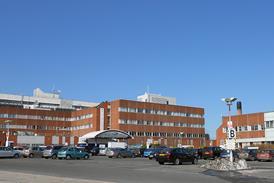In choosing a radio network to revolutionise its blood tracking system, one trust discovered the technology could be better used elsewhere, reports Daloni Carlisle.
When Croydon Health Services Trust won some central funding to test out mobile, real time electronic blood tracking systems in a district general hospital, it did not end up where expected. It now has a radio frequency identification network (RFID) and has learned valuable lessons about clinical IT implementation as it progresses with the installation of a new patient administration system – but not the blood tracking system that was envisaged.
The original plan was to use the Right Patient, Right Blood pilot project to test whether the Olympus BloodTrack Courier could be integrated into the hospital patient administration, electronic requesting and pathology systems in a district general hospital. It allows a hospital to track blood samples, including blood transfusions, and marry them to the right patient throughout an inpatient episode. It moves the hospital from handwritten labels on patients and blood samples to barcodes that are electronically scanned.
Blood tracking had already been used at the Oxford Radcliffe Hospitals Trust – a teaching hospital where it had shown to be safer and more efficient than traditional, paper-based processes (see case study below).
“This was very clearly about what is realistic in a district general hospital,” says Tony Newman-Sanders, now medical director at the trust and responsible for the pilot. “We are not a teaching hospital with secondary resources to put in.”
Croydon wanted to go one step further than barcode scanning and explore how to make the system wireless by using RFID and mobile devices. This would bring the process to the bedside and allow real time tracking.
“We wanted to look at technology to improve patient safety,” says Dr Newman-Sanders. “We knew that blood safety on its own was not going to justify the level of investment required for implementing an RFID network but we did feel that the Right Patient, Right Blood pilot could leverage the initial investment that would allow us to explore other uses of RFID.”
This was never going to be easy – and in the end it proved a step too far. “We always knew that using the RFID as a component of blood tracking was going to require conversations with several of our [IT system] suppliers,” says Dr Newman-Sanders. “For example it required a major upgrade of our pathology system and, in the end, that was insurmountable.”
Changing direction
Midway through the pilot, the trust got the go-ahead under the National Programme for IT to implement a new patient administration system – Cerner Millennium. This changed everything. “We will now be changing our pathology supplier,” explains Dr Newman-Sanders.
But that does not mean the experience was wasted. “We have learned a tremendous amount – both positive and negative,” says Dr Newman-Sanders. It is knowledge that he will take forward as Croydon examines exactly what it wants Cerner Millennium to deliver and how the trust approaches clinical IT implementation.
For a start, the trust has learned that one mobile device and one way of presenting data does not suit all levels of staff. Practically, this prompted the trust to set up a “fashion show” for clinical staff to try out different mobile devices as part of the preparatory work for Cerner Millennium.
The trust has learned the difference between a safe system and a usable one. “From a safety point of view, we designed a system that required a re-scan of a barcode as a fail safe. But for the nurse using it, this was another step and it led to a perception that this was more hassle than the old system. We learned that safety and usability issues are both real; it’s no good designing a system nurses won’t use.”
The trust also gained an understanding of how blood transfusion prescription needs to be brought into e-prescribing. “We are working with Cerner on this and will be the first Millennium medicines management roll-out,” says Dr Newman-Sanders.
The investment in a limited RFID network for the blood project did indeed provide the trust with the impetus to roll-out RFID to a wider network that would cover all wards and departments, and is already being put to good use. For example, Croydon University Hospital (formerly Mayday Hospital) now uses the VitalPAC system to electronically record patients’ vital signs at the bedside, with results transmitted electronically over RFID.
“There has been a rapid roll-out and enthusiastic adoption of VitalPAC,” says Dr Newman-Sanders. “It’s something that is done by everybody, everywhere, all the time so it is much easier to do a rapid roll-out and pick up problems on the fly.
“That’s quite different from BloodTrack, which is used by a small number of people infrequently. I think that is one of the unequivocal lessons: piloting IT-enabled change will always be a problem if it is something done by a small number of people in a small geography.”
Pilot projects to test out different uses of the RFID have had mixed results. A cold chain tracking system was abandoned when the electronic temperature sensors proved unreliable.
Likewise, a plan to track mattresses to prevent transmission of C difficile infections was obviated when other measures reduced the infection rate effectively to zero. But others are going ahead including high asset management tracking and the blood tracking will be revisited with the new patient administration system. So although this was a pilot project that did not deliver what it was supposed to, it is one that has delivered much more instead.
“We now have a much more structured understanding of RFID,” says Dr Newman-Sanders. “But most importantly, we have gained a real understanding of how we make systems safer by putting identification at the bedside. Without patients at the front end, and without their engagement in identification and information systems, you create clinical risk.
“The Achilles heel of information systems is that they can divorce clinicians from patients. You get the clinician looking at the screen, not the patient, or leaving the bedside to identify the patient. We will be uncompromising in making sure that however clever the systems are, we maintain that patient interface.”
The benefits of barcodes: case study
The John Radcliffe Hospital in Oxford piloted an end-to-end clinical and laboratory transfusion service from 2001 to 2005, rolling it out across what is now the Oxford Radcliffe Hospitals Trust in 2006-07.
The trust had wanted to improve transfusion safety, reduce the inappropriate use of blood, improve efficiency and improve compliance with regulatory requirements. The solution involved redesigning the hospital blood transfusion system and incorporating barcoding for patients and blood samples. This automated process enabled accurate blood tracking and a complete audit trail.
The new system realised both cash releasing savings of £420,000 and productivity savings of £500,000. The trust suggests net savings of £86,000 per 100,000 of the population.
Safety also improved. In the five years from September 2001, there had been no ABO incompatible red-cell transfusions (the most serious type of wrong blood transfusion) at the trust. There had been only two minor incidents (a rate of one in 85,000 transfusions against the benchmark of one in 13,000).
Blood usage fell and there was a reduction in wasted blood due to poor labelling.
Audit also showed that before implementation of the pilot, only 11.8 per cent of staff followed the process for correct identification; after implementation, this rose to 100 per cent.



























No comments yet